by Melanie Crew
Managing Editor
Dayna Noffke, lover of all things retro, Jill of all trades and local filmmaker (ThrillRide Pictures), joins the gore-tastic ranks of the inaugural WOMEN IN HORROR FILM FESTIVAL (WIHFF) brought to you by Festival Directors Kool Kat Vanessa Ionta Wright (“Rainy Season”) and Samantha Kolesnik (“I Baked Him A Cake”). The festival invades Peachtree City promising a weekend filled to the bloody brim with kickass independent women filmmakers, creators and horror film enthusiasts. You won’t want to miss the horrorific lineup of shorts and feature-length films, panels, vendors and special guests including Heather Langenkamp (A NIGHTMARE ON ELM STREET), Amanda Wyss (A NIGHTMARE ON ELM STREET/BETTER OFF DEAD), Marianne Maddalena (SCREAM), Lynn Lowry (CAT PEOPLE/THE CRAZIES), Trina Parks (DIAMONDS ARE FOREVER) and more! Noffke has been given the excruciating task, yet a highly rewarding opportunity to get a sneak peek at the talent before it’s unleashed on the unsuspecting masses, as a WIHFF film judge. Competitor’s films for the film competition will screen throughout the festival weekend (Friday, September 22, 12:00 p.m. – 10:45 p.m.; Saturday, September 23, 12:00 p.m. – 8:30 p.m.; Sunday, September 24, 12:00 p.m. – 6:45 p.m.; Crowne Plaza Atlanta SW – Peachtree City; Tickets $45 day pass ($55 at door) / $125 full fest pass ($140 at door); and $200 VIP Fest Pass (includes all speakers, workshops, films and special events including the Thursday night VIP party); Schedule for each screening block here; Tickets here)! Kick off this season of horror and make your way to the WIHFF, take a walk down the “Dead Carpet,” and experience a weekend full of killer cinema!
Noffke’s film career began in 2008 when she was cast as an extra in Rob Zombie’s HALLOWEEN II (2009). She’s been churning out what she calls “backyard no/low budget” short films ever since, while working part-time as a set dec-buyer/dresser (V/H/S VIRAL, THE VAULT) and working towards directing full-time, with no end in sight. Since 2009, Noffke’s made ten short films including “Safety First” (2009); “Mouse” (2012); “Picnic” (2012); “Recompense” (2014); “Under the Bed” (2015); with her latest being “Teaser,” which wrapped this past week. She’s also written three feature film scripts, which have done well in the screenplay contest circuit, prompting her to take the next step to produce a feature-length film in the near future. As a filmmaker who has had some pretty amazing life experiences  (researched Mantled Howler monkeys in Nicaragua; took Gross Anatomy and dissected a human body, just to name a few), Noffke seems to be a perfect choice to judge some of the best independent horror films coming our way this year.
(researched Mantled Howler monkeys in Nicaragua; took Gross Anatomy and dissected a human body, just to name a few), Noffke seems to be a perfect choice to judge some of the best independent horror films coming our way this year.
ATLRetro caught up with Dayna to chat about the Women in Horror Film Festival, what inspired her to dive head first into the film industry, her favorite horror movies as a kid, and rooting for kickass final girls. While you’re taking a stroll through our little Q&A, why not take a peek at a couple trailers for some of her short films here.
ATLRetro: How exciting to be a part of the inaugural WOMEN IN HORROR FILM FESTIVAL! Can you tell our readers how you got involved and a little about your role as film judge?
Dayna Noffke: It is exciting! We’re fortunate to have so many amazing film events in Atlanta and this is a wonderful addition. When I heard about the festival, I knew I wanted to be involved but I wasn’t certain that I would have a new film finished in time to submit for this year. I submitted to the organizers’ call for judges and before I knew it, I had a queue full of fantastic film work to review.
What’s it like to judge films of women who have dedicated their creativity and professional lives to the horror genre?
It’s an honor to be entrusted with these films. I have been in the role of judge for a few different festivals now and I always take it very seriously. I know what it’s like to be on the other side — to have your work put out there for review, and I try to remember that and give each film my full attention and consideration. All of these filmmakers have my respect, because getting any film finished requires Herculean amounts of persistence and hard work. I greatly enjoyed judging, discovering new talents and seeing the evolution of those creators with whose work I am familiar.
We see that you’ve been involved in filmmaking since about 2008, when you were an extra in Rob Zombie’s HALLOWEEN II. What was it about that particular film production that made you want to make movies?
The experience of being an extra on that film gave me two things. First I was given the ability to see the filmmaking process and the roles on set, including watching a director who really enjoys his work. And secondly, I had a great freaking time on set. I felt very at home. It was a light bulb moment for me. All my life, I’d been struggling and bouncing through trying out different artistic disciplines with none of it ever “clicking.” Here it was. I got it. Prior to that experience, it wasn’t in my frame of reference to think of making films as something that I (and my friends) could do. Sure, I realized in an abstract sense that people were making them, but I hadn’t seen it up close and it was a separate world that I’d never experienced. Watching RZ direct that film changed my perspective, so yes – in a strange, roundabout way, Rob Zombie is responsible for my leap into the film world.
It was once thought that horror films were made by and generally made for a male audience. Of course we adamantly disagree, as horror is definitely right down our alley, especially pre-21st century horror. Can you tell our readers what drew you to the genre and why it keeps drawing you in deeper and deeper, as your own filmmaking career continues to grow?
The million dollar question. Why? Why are we so drawn to this darkness? I am actually a pretty light-hearted person. I consider myself lucky to have a great life that’s full of adventure and joy – which makes it perhaps even more of a puzzle. For me, I guess it is twofold. First of all, there’s the thrill. There is nothing like that feeling of being at the top of the clicking roller coaster hill or just before the corner in the haunted house – the anticipation, wanting to scream and laugh and run all at the same time. Monsters are fun, they’re fantasy, but most importantly, they’re an escape. Second, I am fascinated with human beings and that translates into a desire to understand them. While I certainly don’t empathize with people who are able to do horrible things to other people, I want to ‘get it.’ I want to know what makes them tick. Why do these things happen? I want to find sense and make something out of the chaos. I love writing about the survivors. I’m in awe of kickass final girls.
You’ve been employed in several roles in the film industry, including set decorator-buyer, writer, director, producer, etc. Is there any particular role you prefer over the others and why?
One of my favorite things about film is the collaborative nature of the art form. Working in different departments has given me an appreciation for the importance of the different aspects of filmmaking and a better view of the process holistically. I’ve been working professionally, for the past four-something years, as a set decoration buyer. I enjoy the work and it’s helped to develop my design eye, which has translated into better visuals in my own filmmaking. But ultimately, I want to write and direct. I want to be out there telling stories. I’m currently working on making that jump from set dec to being full time on my own projects. As for producing, I have done a lot of that on my projects out of necessity and while it’s a good learning experience, it’s not where my talents lie. I had a great producer, Chris Ethridge, on my most recent short, “Teaser,” and he was a lifesaver. I’m glad to hand that part over to people who are better-suited to the task.
Who are your favorite female horror directors and why are they your favorite? Were there any female role models in the horror genre that particularly inspired you growing up?
I wasn’t really a monster kid. I was a kid who loved just about everything having to do with stories and pretending – from dolls to Grease to Star Wars – and also happened to be into all kinds of movies. I did always love the final girls who made it to the end of the horror movies — Nancy and Alice and Laurie, particularly. My list of favorite female directors is a long one! Not only are there the big ones, like Mary Harron – whose AMERICAN PSYCHO is a vision of absolute, all-out abandon – but there’s a huge list of indie filmmakers who are making waves in both short and feature length formats. Jen and Sylvia Soska, Karen Kusama, Izzie Lee, Jill Sixx, Lynne Hansen, Tonjia Atomic — the list goes on and on. What they all have in common is guts. They’re all out there taking chances and getting their stories told however they can. Their art is gorgeous and brave. I’m also a huge fan of the actors who make directing such a great job. I have been honored to work with Madeline Brumby (FRANKENSTEIN CREATED BIKERS, SPRING BREAK ZOMBIE MASSACRE), Katherine English and burlesque star Lola LeSoleil among others.
What would you say was your gateway drug/film that enticed you into the land of horror films?
The first real horror film I remember seeing is SILENT SCREAM. I recall that shortly after, my brother and I went on a FRIDAY THE 13TH and JAWS watching spree. I’d set the alarm to get up and watch films on Cinemax in the middle of the night. MY BLOODY VALENTINE also figures prominently into my childhood.
Can you give us five things you’re into at the moment that we should be watching, reading or listening to right now— past or present, well-known or obscure?
Just five? I love reading, music and films, so I’m always on a tear. There are two books that I cannot recommend highly enough. DEVIL ALL THE TIME by Donald Ray Pollack is a jaw-droopingly dark and poetic trip into the Southern Gothic. It’s unlike anything I’ve ever read. I’m also reading THE WITCHES: SUSPICION, BETRAYAL AND HYSTERIA IN 1692 SALEM by Stacy Schiff. It’s full of great information but not particularly academic, a more human approach to the Salem Witch trials story. As for films, Karen Kusama‘s feature film, THE INVITATION, is incredible. I’ve re-watched it a few times. It’s got a very tight, effective story and a killer cast. I will also add to the list of people singing the endless praises of Jordan Peele‘s GET OUT. It’s just that good! Since it’s September, I’m in heavy rotation on monster bop/classic Halloween music. I’m enjoying my new birthday present – Waxwork‘s limited edition MY BLOODY VALENTINE LP with score and music from the film.
also add to the list of people singing the endless praises of Jordan Peele‘s GET OUT. It’s just that good! Since it’s September, I’m in heavy rotation on monster bop/classic Halloween music. I’m enjoying my new birthday present – Waxwork‘s limited edition MY BLOODY VALENTINE LP with score and music from the film.
What was your favorite horror film growing up?
As a child, JAWS all the way. My brother and I had a best friend who had a pool. We’d get the VHS and make a ‘movie theater’ with tickets, watch the film and then scare ourselves into a frenzy thinking that Jaws lived in the pool. I’ll also have to admit that we chased my brother around an awful lot as Jaws so… apologies on that front. As a teenager, I really loved cheesy horror – things like MICROWAVE MASSACRE, TOOLBOX MURDERS and the like. I got hooked on RETURN OF THE LIVING DEAD, EVIL DEAD and TEXAS CHAINSAW MASSACRE then, too, and that has definitely stuck. TCM is my favorite to this day.
As an independent female filmmaker working in the horror genre, what challenges have you personally faced that seem to be a common theme amongst women in the industry?
While I hesitate to speak for every woman in the industry, I’ve certainly heard enough stories and had enough experiences to see that there are definitely barriers to being heard as female filmmakers. I have been put in incredibly uncomfortable positions at cons and film festivals, where I wanted to be involved in the film conversation but was compelled to speak up and/or leave because of the incredibly casual misogynistic and ugly talk about other women. All I could think was, “If they are saying this while I am standing right here, what are they saying about us when I’m NOT here?” I’ve been followed to my hotel room at night by creepy guys and on and on. These types of harassment are barriers to all women – not just filmmakers – feeling comfortable attending and enjoying film events and that sucks. I’m heartened to see a lot of men starting to speak out about this and standing up beside us to put an end to this kind of behavior. There are other problems, of course. Sadly, it’s a long list.
Any advice for women filmmakers out there trying to get their foot in the door?
Show up. Help other filmmakers with their projects and support them in their successes and challenges. Make movies whenever you can – it’s the only way to learn. Community makes the indie filmmaking world go round. Be relentless. The first time funding fell through for my feature, I was crushed. But I quickly realized that it’s probably going to  happen a few dozen more times before that film gets made. Keep moving forward. We want to hear what you have to say.
happen a few dozen more times before that film gets made. Keep moving forward. We want to hear what you have to say.
As a filmmaker, and a film judge for the WIHFF, how does the competition look? Anything spectacularly horrorific and exciting you can tell us without giving too much away before the festival? Any particular film we should definitely check out?
Hmmm. I’m not sure what I’m allowed to give away so I’m going to plead the fifth on this one. But trust me, the competition is FIERCE. You’re really going to enjoy this festival – it’s got everything from fun over-the-top gore to horror comedy and creature films to beautifully realized horror poetry.
What are you looking forward to most about the festival?
I’m really looking forward to meeting the filmmakers! I love catching up with the ones who I know and seeing what’s up next for them but I’m also excited to meet the creators of the films that I judged. There is so much talent out there.
And last but not least, what are you up to next? You’ve indicated that in 2018 you’ll be working on a feature-length project based on a screenplay you wrote. Can you tell us a little about that, and any other projects you’re currently working on or will be in the near future?
I have several projects in the works right now. I’m forever writing screenplays – who knows where they will take you? I finally finished up my short film, “Under the Bed” last month. It’s a fun little creature film that stars my daughter and one of my best friends – so we had a great time making it. I’m busy entering it into festivals right now. We wrapped on my latest short, “Teaser” last weekend. It’s a very lush and poetic burlesque-themed short and my biggest production so far. We have a hard deadline for getting it through post, so you can expect to see it at festivals soon! I am slated to shoot another short film, “Shark: A Love Story” for a local production company sometime at the beginning of the year. That one has a lot of special FX — blood everywhere! It’s going to be crazy!
I also have three feature film scripts that have been bouncing around for a while but nothing solid on production yet. It’s my goal to shoot my psychological thriller, EIDOLON, in 2018. It’s a very sparse psychological/paranormal thriller — a re-imagining of the classic Victorian short horror story, “The Yellow Wallpaper.” My feature script, GET CHINO! is a comedy/grind-house hybrid about five fan girls who kidnap their favorite action star in a bid to get him to star in their film. The screenplay has been chosen as an official selection at Oaxaca Film Festival this year and I’m looking forward to hearing some feedback on that one as well and maybe roll on it in the next few years.
All photos courtesy of Dayna Noffke and used with permission.

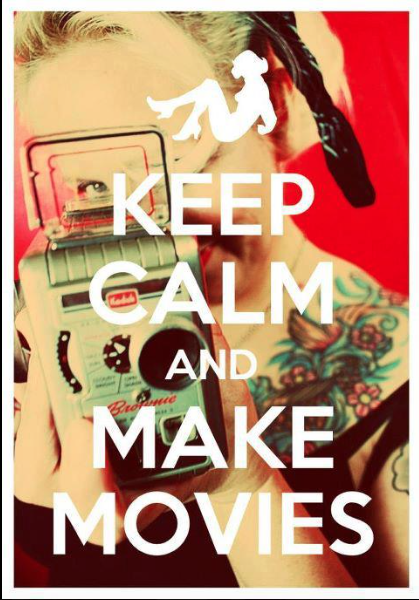
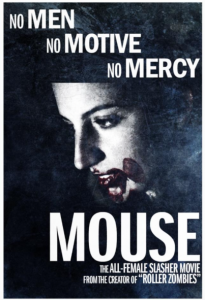
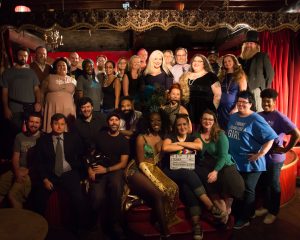
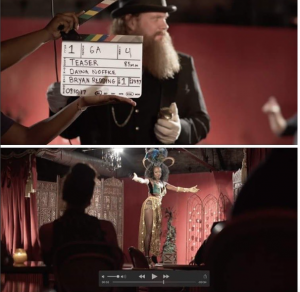

 Universe.
Universe.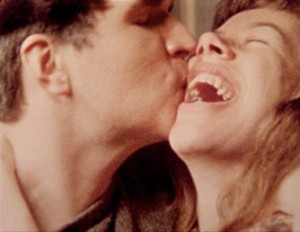
 and sent him a letter, so he called me up and said he loved me and to come and visit him. It was about six weeks later that we married.
and sent him a letter, so he called me up and said he loved me and to come and visit him. It was about six weeks later that we married. language first and English as a second language. In my early 20s, I wanted to write a dog dictionary. Years later, three people told me about the time when they lived “way up the road beyond where the snowplow went across a winter and they watched a wolf and his mates.” I was very charmed by this story, but couldn’t figure how to present it. I finally realized that I could write it from the viewpoint of the wolf. But even then, people would read it and still they wouldn’t learn the language. So I added notes, talked about why the animal made that gesture, what it meant. To me it seemed obvious as pie. So that’s WOLF DICTIONARY. It’s a key to start understanding animals and what they are communicating.
language first and English as a second language. In my early 20s, I wanted to write a dog dictionary. Years later, three people told me about the time when they lived “way up the road beyond where the snowplow went across a winter and they watched a wolf and his mates.” I was very charmed by this story, but couldn’t figure how to present it. I finally realized that I could write it from the viewpoint of the wolf. But even then, people would read it and still they wouldn’t learn the language. So I added notes, talked about why the animal made that gesture, what it meant. To me it seemed obvious as pie. So that’s WOLF DICTIONARY. It’s a key to start understanding animals and what they are communicating. Which writers (poets, novelists, etc.) influenced you the most?
Which writers (poets, novelists, etc.) influenced you the most? be properly tucked away into a single box? Or do you think most art (including film) overlaps several different genres?
be properly tucked away into a single box? Or do you think most art (including film) overlaps several different genres? They can expect to be surprised about a number of things.
They can expect to be surprised about a number of things.